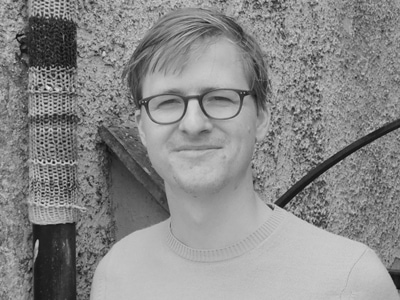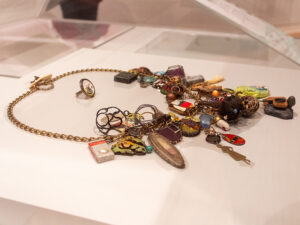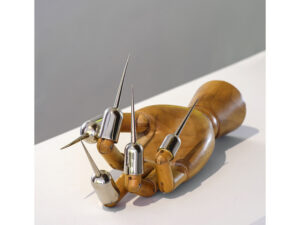The London Design Festival (LDF) that took place in September 2011 is London’s annual celebration of design in the broadest possible sense, ranging from large architectural installations to precious gems under glass, the work of students in pop-up galleries to luxury furniture stores on Brompton Road. This year, the organizers latched on to the words of United Kingdom Chancellor George Osborne’s budget speech: ‘We want the words “Made in Britain,” “Designed in Britain” and “Invented in Britain” to drive our nation forward.’ They positioned design at the forefront of this growth strategy, praising its dynamism in London in particular and the suggestion it is able to make valuable contributions to the nation’s cultural and financial sustenance.
This exuberance for design was manifest in the throngs of people that clogged Brick Lane in London’s East End during the weekend, with its galleries, fairs, bars and independent stores. Design, art and fashion all mixed together with the intensity of any of the street’s hot curries. Areas in London often frequented by a trendy clientele are supercharged during the LDF and each design devotee creates their own route through the plethora of places to be, with the help of their little red book (the LDF’s free catalog) or the ICON magazine’s handy Design Trail.
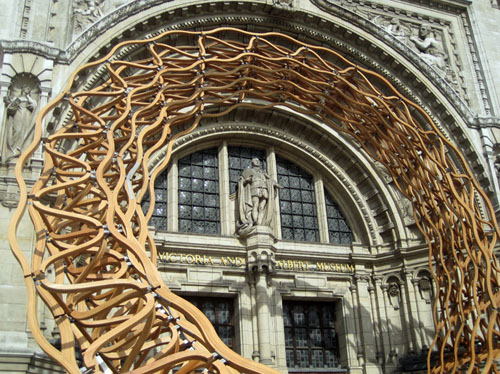
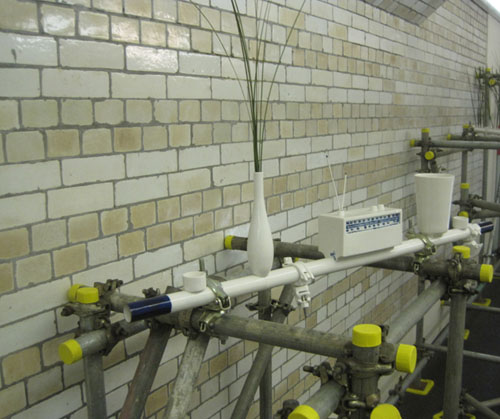
In the British Galleries, curator Giles Deacon carries on a long tradition of gallery interventions with students from the University of the Arts, London. Student work sat between pieces of early modern design, sometimes in a spectacularly incongruous fashion – such as Matthew Nicholson’s Making the Desirable Accessible Through an A4 Printer, a mannequin dressed in a smart suit with Rolex and Leica camera additions and shoes, all made of colored A4 paper, placed alongside Empire revival furniture. Others created narratives out of the gallery space, such as Michelle Lewn’s eerie Patient Number 1146, a sculpture of a man looming in the corner of the late eighteenth-century Strawberry Room. This Where’s Waldo? of student work reflects one of the features of the LDF: a chance to see output from students and lesser-known practitioners.


Among the pop-up stores and temporary exhibitions you had to hunt out the most engaging work. The pick of the bunch in terms of jewelry was Silver-Where at Gallery S O in Brick Lane that showcased the work of recent graduates from the Royal College of Art Goldsmithing, Silversmithing, Metalwork and Jewellery Department. Silver, normally at the center of jewelers’ craft, was conspicuously absent and works were more experimental and harder to place in conventional material-specific mediums. Also impressive was the work Wooden Forms by Peter Marigold in Paper Tiger. It was an exercise in tooling in which the same five-inch, small piece of wood was pasted with quick-dry hot wax again and again, each new wax mould starting where the previous one left off. The final wax form – ‘an amalgam of moments’ according to the leaflet accompanying the work – was then cast into metal or plaster to create pot-shaped objects, the end result of the simple, repetitive process. Like the pixels on a digital image observable when we touch up photos on Photoshop, each mold of the wood relates to a wider whole. The difference is that in Marigold’s piece each constitutive part is hand-made, a feature emphasized by the way the green wax mold on occasion pokes through the completed, final cast.
Timed to coincide with the LDF, the Origin Craft Fair run by the British Crafts Council was an extensive if somewhat cramped showcase of contemporary craft held in the Old Spitalfields Market. The fair is set up with stalls either side of narrow corridors, much like a smaller version of the Frieze Art Fair and it is not the most conducive environment for perusing contemporary jewelry, metalwork, ceramics and textiles. In this assemblage of stalls there were countless examples of handcrafted wonder – a demonstration of London’s pre-eminence as a center for lovingly and luxuriously embellished objects.
However, as I zigzagged between the works what particularly grabbed my attention was the number of practitioners using found objects, most notably appliqué and paper-cutting techniques. Claire Brewster had created miniature artworks from vintage maps, Jennifer Collier used recycled papers for her teacups and garments, Sarah Morpeth made nature-themed paper collages, Uoldbag.com was a more commercial outfit in this arena and Rebecca Coles’s paper butterflies referenced the longstanding hobby of lepidopterists. Use of readymades within jewelry and other craft is clearly well established, with prominent figures like Lisa Walker bringing together conglomerations of found stuff. But in these examples the use of vintage books as raw material irks those of us with a fondness for antique books. I wanted their work to more fully interrogate why paper was being used, beyond it just being something decorative and funky.
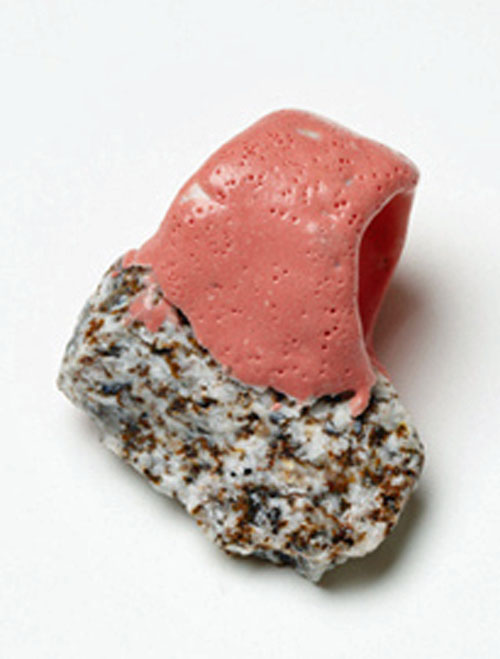
Back at the V&A two major exhibitions opened in time for the LDF, the Power of Making and Postmodernism: Style and Subversion (and continue running until January 2012). Both deserve reviews in their own right – and there have been many – but I will finish with a few words on the Power of Making, as it constitutes some form of response to Osborne’s call for Britain to ‘make’ its way out of economic trouble, celebrating the creativity and ingenuity of the country’s craft industries.
The giant gorilla that welcomes you to the exhibition, made out of wire coat hangers by David Mach, seems to emphasize the importance of ‘power’ in the exhibition’s title. There is a lot of macho craft on show: from the decorative mechanical overload of the several customized ‘blinged bikes’ and a ridiculous multi-headed guitar, to the technologically impressive procedures of facial reconstruction surgery. The representation of craft practices, like wicker basket making, cake decoration, crochet and lace embroidery seemed to ensure their inclusion in the show only by doing something extraordinary or spectacular, at least enough to prompt sighs of awe or bemusement from the crowd. P H Coate and Sons use wicker basket-making techniques to craft an eco-friendly (yet highly conspicuous) coffin, Michelle Wibowo’s cake decoration depicted a baby in icing with Ron Mueck-like detail, crochet techniques were used by Shauna Richardson to make a taxidermy bear (the show’s second big animal) and the Polish lacemakers of the village of Koniakow, who previously supplied the pope, had found a new market in selling intricate G-string underwear. In this exhibition, craft, much marginalized as a category of visual culture and industry, seemed to be searching for its pin-ups.
Halfway through the exhibition you enter a ‘techy’ corner, where the background hum of the audience quietly chatting is overlaid by beeps and the noises of 3-D printers. When I visited these micro-factories were in action, materializing sketches that children had drawn on paper. Projected on the wall behind this high-tech workshop were short films of various craft procedures submitted via the on-line media-sharing site, Vimeo. This allowed for some striking contrasts: while I was there a documentary film showed collaborative metalworking from Dhaka, Bangladesh, with six workers shaping a pile of metal dishes through loud, repeated hammering. Temporarily, my attention was drawn away from the technical gadgetry on show.
There was also another area of the gallery where film displayed a variety of craft techniques – to good effect – creating an overall multimedia environment that surely contributes to the exhibition’s wide popularity. This was purposeful craft, craft reconfigured to attract designers, functional, productive and economically important: it is no surprise that curator Daniel Charney is a senior tutor in the Royal College of Art’s Design Products department. This is welcome and keeps up with the museum’s mission statement to educate its audience in new techniques, but making is not always powerful. It is often ornamental, decorative and aesthetic; features that were under-emphasized in the show.
And in the bevy of celebration of design and making throughout the LDF in general, one still wonders what people in Britain will make to get out of economic trouble? Much of the stuff on offer is impressive and spectacular but is it in danger of losing its closeness to the everyday and wider societal and political ambition?
